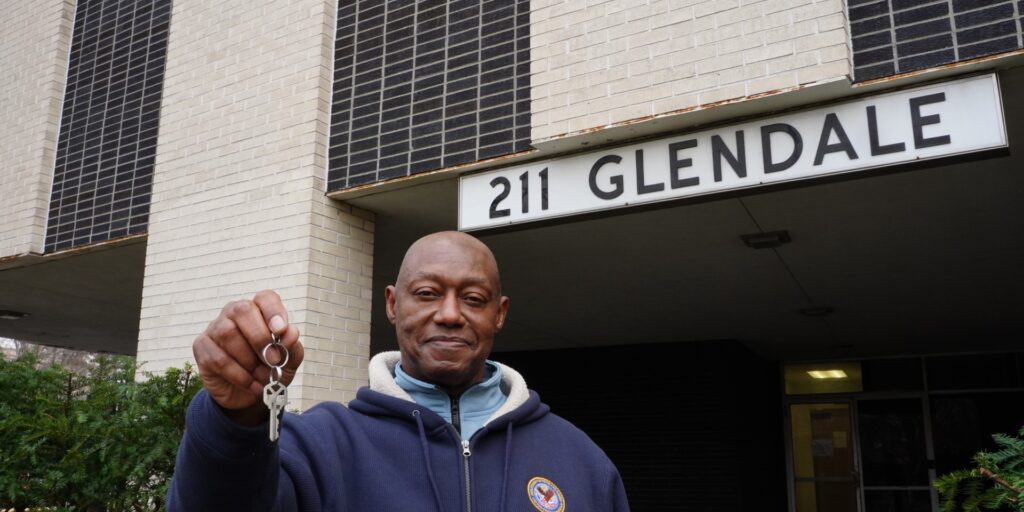Solving veteran homelessness: The pursuit of ‘functional zero’
Zannie Roy Jackson Jr., a Marine Corps veteran, was 53 years old when he began living out of his car on the streets of Detroit. Jackson, who was medically discharged from military service in 1980, worked for the U.S. Postal Service for 18 years before getting into legal trouble and spending time in prison.
“When I came back home, my family had hardly been paying any taxes. I started paying them, but I just didn’t have enough money to keep it up, and I didn’t have (help),” he recalled in a recent phone call. They lost the house, and Jackson “wound up sleeping in my car. I didn’t have nowhere to go.”
He kept clothing in the trunk. The hardest part about it was finding places to shower.
“I had gotten out of prison, and I was in a self-made prison. I was convinced that it wouldn’t get any better,” he said. These days, Jackson, now 63, is a peer support specialist at the Detroit Department of Veterans Affairs. He credits the local VA, which he eventually turned to, for helping him out of homelessness.
Jackson’s success story is one of hundreds—similar to that of Freddie Tucker, pictured above, a previously homeless veteran who recently moved into 211 Glendale in Detroit, which was converted from transitional housing into permanent housing—documented by the local Department of Veterans Affairs. In the last five years, Detroit has reduced its veteran homeless population by nearly 70 percent. Nationally, the number of veterans living in homelessness has declined by about 11 percent since 2020, according to data from the U.S. Department of Veterans Affairs. And since 2010, the estimated number of veterans experiencing homelessness in American cities and counties has been reduced by more than 55 percent.
At a time when rates of homelessness are at an all-time high in many regions, the success of reducing veteran homelessness is being touted by advocates as proof that “functional zero” (the eradication of homelessness) both among veterans and in the general population can be reached—with the right attention, investment, and priorities.
“I think we, collectively as a country, can finish the job of ending homelessness,” said Beth Sandor, chief program officer for the advocacy organization Community Solutions, noting the Obama Administration’s initial nationwide effort to end veteran homelessness. “Historically, nationally, there’s been a huge commitment around ending veteran homelessness.”
But in order to solve the problem, it needs to be understood, first, Sandor said. She stressed the importance of creating systems grounded in universally accessible data, and the importance of building relationships between disparate religious, public and private organizations that interface with homeless people.
“Once you’ve done that work, it lays the foundation to move faster for other populations,” she said.
There is no simple reason that accounts for Detroit’s success. Rather, it has been a lot of in-the-trenches effort—careful documentation, the creation of data systems, and networking by people like Jackson, who intimately understand the challenges many people living in homelessness face.
Creating a system that focuses on individual people instead of providing generic solutions is vital, because every person living in homelessness needs different solutions to be successful.
“When people hear my story, they can relate, and they know I can relate. It makes it more comfortable for them to talk about things they might not be able to talk about (with others),” Jackson said, noting the most important thing anyone can do to help someone living in homelessness is to listen. “I believe, if you don’t treat the addiction and mental illness, you can’t treat the homelessness.”
Detroit’s approach models Community Solutions’ Built For Zero methodology, which is designed around a shared goal of functionally ending homelessness through data-driven, community-oriented work. Currently, more than 100 communities across the United States have officially signed onto the methodology. Sandor noted that many more communities have integrated key aspects of the approach, like making sure disparate service organizations universally track data in one place that’s accessible by all.
Defining an end goal is another important aspect of the approach. Traditionally, homeless service programs are “set up on programmatic outcomes—serving the individual,” as opposed to “equitable reduction in homelessness,” Sandor said.
By aiming for functional zero instead of focusing exclusively on “providing services,” agencies are incentivized to unify community organizations into a regional structure. That way, the organizations operate as more than the sum of their parts, sharing data, best practices, resources, and knowledge.
“How do we have our arms around every program, regardless of funding sources, in a shared database? It is an effort to do that. But communities are doing it. Detroit is mining data across their entire continuum of care organization,” she asked.
The integration of Detroit’s Veterans Affairs homeless program into the region’s broader coordinated entry system and continuum of care, or the body that oversees the region’s homeless system, was an important step early on, according to Jennifer Tuzinsky, a coordinated entry specialist and liaison between the community and the VA’s programs.
Because of the VA’s relationships with other community organizations, whenever a homeless veteran seeks public or private services, the VA knows about it. And the homeless veteran is likewise made aware of the VA support they’re entitled to. These days, Tuzinsky’s team can accurately track the number of homeless veterans and where they’re staying almost in real-time. This lets peer support specialists like Jackson Jr. connect and direct them to the VA’s services—like addiction support, career help or mental health care.
“We’ve made huge reductions,” said Tuzinsky. “When I started in 2018, we had 340 homeless veterans in our byname list, and we’re now down to 106.”
Denver’s metro region is another area that’s successfully reduced its veteran homeless population in recent years. Dr. Jamie Rife, executive director of the Metro Denver Homeless Initiative, attributes the success to Community Solutions’ structured, data-driven approach. And she’s hopeful that the networks they’ve built will help them down the road, as they work to reduce other homeless populations.
The metro-Denver area is about the size of Connecticut, which has historically made providing homeless services difficult. To make things more manageable, Rife says they took the “built-for-zero” framework and applied it locally, breaking the metro area up into nine subregions. Each subregion has built a community-wide network like that in Detroit, and representatives report back to a large oversight group.
“We’ve gone from over 500 veterans when we started a couple of years ago, and we are down to 364 as of August,” Rife said, noting that 284 of those veterans are already connected with housing resources. “We chose veterans as a starting point to learn” where the gaps are. “The goal is to use that as a proof point and then move to different populations.”
Notably, the general homeless population eclipses that of veterans living on the streets. In 2020, the Department of Housing and Urban Development counted around 582,000 homeless people in America. Comparatively, the Department of Veterans Affairs most recently counted 33,129 homeless veterans. Further, the VA’s robust health care network provides free services, acting as a central hub for veterans in need. Creating a similar network to serve the civilian population requires a lot more work—but at the end of the day, the needs are the same, and so is the solution.
“Most of the people who are homeless are one good decision away from being in the mainframe of society,” Jackson said. The primary challenge is figuring out “not just what they need, but what they want. Sometimes people are OK with just having nothing. Some people may not have experienced that, but I have. I know that what I did is no different than what anyone else can do.”
For more information, visit Community Solutions’ website.



















